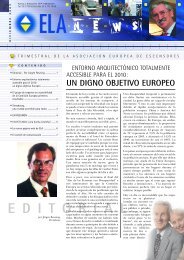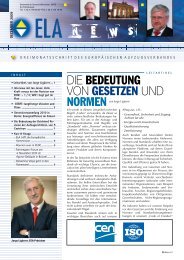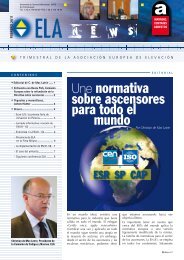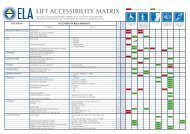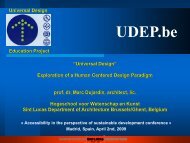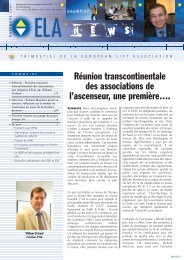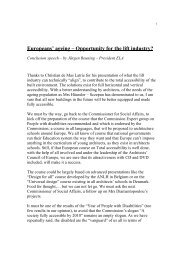WP6-Brochure-E4 brochure - ELA European Lift Association.
WP6-Brochure-E4 brochure - ELA European Lift Association.
WP6-Brochure-E4 brochure - ELA European Lift Association.
Create successful ePaper yourself
Turn your PDF publications into a flip-book with our unique Google optimized e-Paper software.
esults were presented and discussed at meetings of the two German lift associations (VFA‐<br />
Interlift, VDMA). Additionally, the results were discussed in a telephone conference organised<br />
by <strong>ELA</strong>, including five <strong>ELA</strong> representatives. These discussions contributed to fact verification, in<br />
case of contradictory information resulting from interviews, as well as to adding additional<br />
facets to the data. In sum, a homogeneous picture could be formed based on the data<br />
gathered and this will be summarised below.<br />
6.5.4. Identification of relevant barriers<br />
General market characterisation regarding energy efficiency<br />
Interview partners agreed that the energy efficiency of lifts and escalators are increasingly<br />
being discussed. While some state that the topic has already almost reached its peak and is<br />
expected to lose significance in the future, others assume that the discussion has just started<br />
and expect it to be continued and deepened.<br />
These different perceptions of the current state of the discussion can be explained by several<br />
trends. Those who already see the debate losing momentum claim that it was initiated about<br />
two years ago by manufacturers of installations and specialised consultants. Main issues were<br />
technological advancement and how energy consumption could be measured in a<br />
standardised way, but also the integration of energy efficiency into marketing strategies to<br />
promote products. However, the discussion is just about to reach the customers, i.e. architects<br />
and construction engineers, construction companies as well as investors. Operators, owners<br />
and, to some degree, also users are expected to join in sooner or later. Thus, the knowledge<br />
and awareness of energy efficiency of these stakeholders is assumed to be still low, while<br />
manufacturers' competence is rising.<br />
Interview partners also state differences between <strong>European</strong> countries, i.e. the newer and older<br />
members of the <strong>European</strong> Union. Interview partners from German‐speaking countries also<br />
emphasised the impact of the German guideline VDI4707 [6]; on the one hand, it provided a<br />
first basis for standardised measurement of electricity consumption, calculation of energy<br />
demand and labelling, on the other hand – at least from their point of view – it has contributed<br />
towards intensifying the discussion about energy issues of installation also in other countries.<br />
The discussion is also observed to be more intensive for lifts than for escalators. Moreover,<br />
awareness is reported to be higher for grand‐scale installations, e.g. airports, and to be<br />
especially low for small‐scale residential buildings.<br />
A topic that is heavily debated in this context is the economic efficiency of energy‐efficient<br />
technology. Few examples of measures are given where economic pay‐off is not doubted by<br />
the experts surveyed, e.g. turning off the light if the car is not in use. For other measures, e.g.<br />
investing in the drive system, opinions were diverse and heterogeneous – even among experts<br />
from manufacturing and notified bodies. Experts also gave contradictory prices for<br />
technological measures, which, of course, led to differing opinions regarding economic<br />
efficiency.<br />
93





